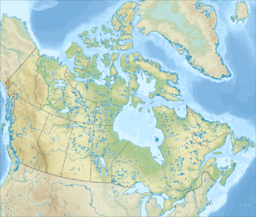Anderson River (Northwest Territories)
| Anderson River (Kuuk) | |
| Beghula, Inconnu | |
| Country | Canada |
|---|---|
| State | Northwest Territories |
| Tributaries | |
| - left | Carnwath River |
| Source | Colville Lake |
| - location | Sahtu Region |
| - coordinates | 67°18′N 125°43′W / 67.300°N 125.717°W |
| Mouth | Arctic Ocean |
| - location | Beaufort Sea, Inuvik Region |
| - elevation | 0 m (0 ft) |
| - coordinates | 69°43′N 129°00′W / 69.717°N 129.000°WCoordinates: 69°43′N 129°00′W / 69.717°N 129.000°W |
| Length | 692 km (430 mi) |
| Discharge | for below Carnwath River |
| - average | 141.56 m3/s (4,999 cu ft/s) |
| - max | 1,520 m3/s (53,678 cu ft/s) |
| - min | 4.65 m3/s (164 cu ft/s) |
| River source, names | |
The Anderson River (Inuvialuktun: Kuuk, river) is in the Northwest Territories in northern Canada. It originates in lakes northwest of Great Bear Lake; its headwaters are possibly on the north side of Colville Lake in the vicinity of the hamlet of Colville Lake. It flows north and west in the area between the Mackenzie and Coppermine Rivers. Its mouth is on the Beaufort Sea on the Arctic Ocean near the eastern end of Liverpool Bay at about 70 degrees north latitude. Its main tributary is the Carnwath River. Originally known as the Beghula River it was renamed to the Anderson River in 1857 by Roderick MacFarlane after James Anderson, both of the Hudson's Bay Company. Anderson was the Chief Factor in the Mackenzie District.
The Anderson River's northwestern sloping drainage basin is a part of the Anderson Plain High Subarctic (HS) Ecoregion, itself a subsection of the Taiga Plains Ecozone and the Anderson Upland Low Arctic north (LAn) Ecoregion, which is part of the Southern Arctic Ecozone. The river encompasses wildly varied landscape. Canyons are common in the upper and middle sections, the largest of which is Falcon Canyon, at 6 km (3.7 mi) long and approximately 40 m (130 ft) deep. The upper sections of the river are in taiga, with black spruce being the dominant tree. White spruce and shrublands grow on the river's floodplain and valley slopes. There are large deposits of alluvial terraces, along with cretaceous shales, Devonian limestone, and Devonian dolomite. Closer to the ocean, the river pulls above tree line, and continues through rolling tundra east of Inuvik.
...
Wikipedia

